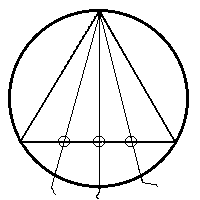|
Dish interference: Site shielding Correcting VSAT dish distortion Antenna gain and beamwidth calculator |
How to make the rim of a parabolic antenna flat, using fishing line.
Dish antennas, be they circular axi-symmetic or offset designs normally have a rim that is intended to be flat. Achieving this flat surface is critical to optimum performance. Using fishing line you can measure the flatness and then make adjustments until perfectly flat. Aim for a flatness error in the order of 1/10 to 1/16 of a wavelength.

The principle is to define a reference flat surface that intersects the dish edge at three equally spaced points. At these three edge points the dish error is thus by definition zero. Intermediate points are then measured and adjusted until they also are zero.
Using fishing line, construct a large, normally equilateral, reference triangle across the face of the dish. Use clearly defined points that preferably coincide with the tips of three ribs. So on a 12 panel dish the points of the fishing line triangle would appear at the tip of every 4th rib. Make sure the fishing lines are all pulled equally tight and are well secured. Adhesive tape applied to an end of the fishing line and attached to the back of the dish is one way of securing it.
Take a new length of fishing line and attach one end to an apex of the triangle, such as the one at the top in the figure. Pull the fishing line tight across to the other side of the reflector somewhere between the two opposite apexes, i.e. somewhere along the bottom in the figure. Moving between these two apexes keep the line tight and observe for the amount of gap between the lines where they cross, marked with circles. If they press down on each other then simply put the loose end underneath. If it is a 12 panel dish there will be three ribs in between along the bottom and you need to take 3 measurements as shown. Adjust the 3 ribs accordingly.
Repeat with the loose line attached at the other two apexes of the big triangle and complete the measurements and adjustments at the tips of all intermediate ribs. In practice 3 loose lines may be used, with only 1 used at any time, the others can best be draped behind.
Finally make sure everything is tight and safe and don't fall off the ladder!.
Footnotes:
If you want to be clever, do the above but simply record all the errors. Then draw a graph of the errors, for points 1 to 12 around the edge, and see if you can choose a better starting set of 3 points for the apexes of the reference triangle. This way you might minimise the amount of the adjustments required.
In an even more sophisticated manner you can do the measurements for the 12 points with the dish aimed directly upwards. Adjust the edges. Then repeat the 12 measurements at the operational elevation angle, work out the errors, bring the dish vertical and apply the opposite of the errors. Then when you point at the operational angle you will be fine. I hope!
|
Any problems or comments please e-mail Eric Johnston Page 27 Nov 2007, amended 25 Feb 2022. |